The transformative power of nature is vividly captured within the realm of healing gardens, spaces where tranquility and therapy unite through the gentle tending of flora. Surpassing mere aesthetic allure, these gardens offer profound horticulture wellness benefits, becoming sanctuaries that support and nourish mental health. The intertwining of natural beauty and rehabilitative care in therapeutic landscapes provides individuals with a serene environment to cultivate mindfulness and foster inner peace.
Incorporating garden therapy for mental health into modern wellness practices is a testament to the timeless bond between humans and nature. Through the serene act of gardening, individuals immerse themselves in a sensory experience that can alleviate stress while promoting emotional and physical recovery. Far from being a mere hobby, the benefits of healing gardens resonate with compelling evidence, showcasing their role in enhancing human well-being and offering a naturally therapeutic milieu for all who seek refuge within their verdant embrace.
The Essence of Healing Gardens in Modern Therapy
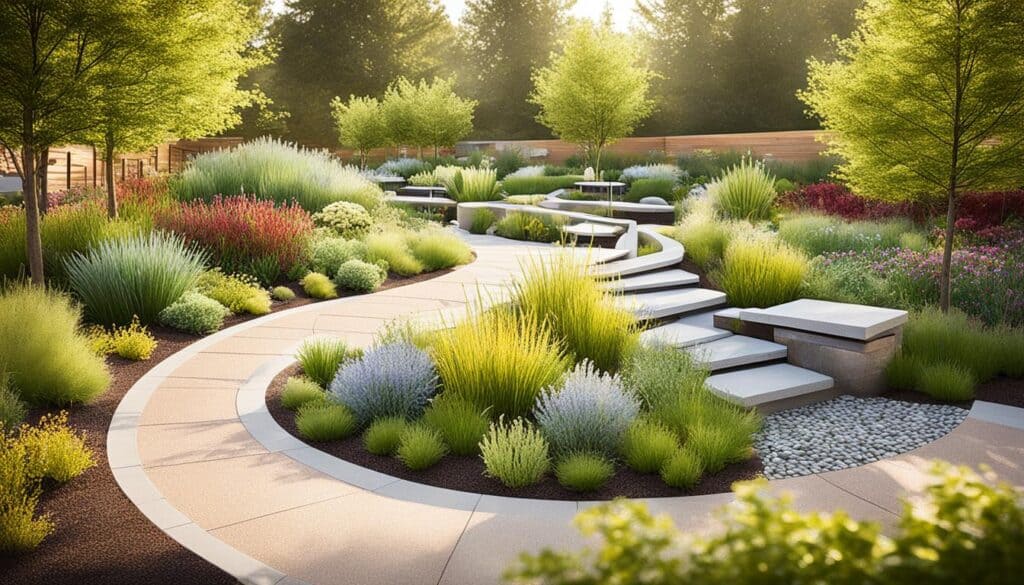
Garden therapy, and its incorporation into modern healthcare and personal wellness routines, is a testament to the enduring power of nature’s influence on well-being. The concept of therapeutic garden design principles is not new, but their application in contemporary horticulture for health initiatives and horticultural therapy programs has gained significant traction as an evidence-based approach for enhancing life quality.
The hallmark of today’s healing gardens lies in their multifaceted nature, integrating sensory experiences with ecological and aesthetic values, ultimately aiming to reduce stress and foster psychological healing. Enthusiasm for these restorative spaces is seen in the growing number of garden therapy projects emerging across diverse settings, from urban hospitals to rural retreats.
Defining Healing Gardens
Healing gardens are specially curated environments, with a focus on plants and landscape design, that target physical, psychological, and social benefits for individuals and communities. These spaces employ therapeutic garden design principles to create serene settings where interaction with nature can facilitate recovery and stress reduction.
The Interplay Between Horticulture and Health
Horticultural therapy programs have underscored the role of plant-based activities in enhancing human well-being. In tandem, the impact of garden therapy on stress reduction is increasingly recognized, supporting the interplay between horticulture and health as a foundation for therapeutic intervention. By engaging participants in nurturing and sustaining green spaces, they offer a means of healing through nature’s innate rhythm and harmony.
- Gardens for active recovery and rehabilitation
- Passive interaction for mental and emotional respite
- Horticulture-based programs for educational and social enrichment
- Nature-based solutions for urban health challenges
Gardens designed with therapeutic intent are not passive landscapes but dynamic ecosystems that respond to and encourage human connection, fostering a healing cycle where both people and plants thrive harmoniously.
Origins and History of Horticulture Therapy
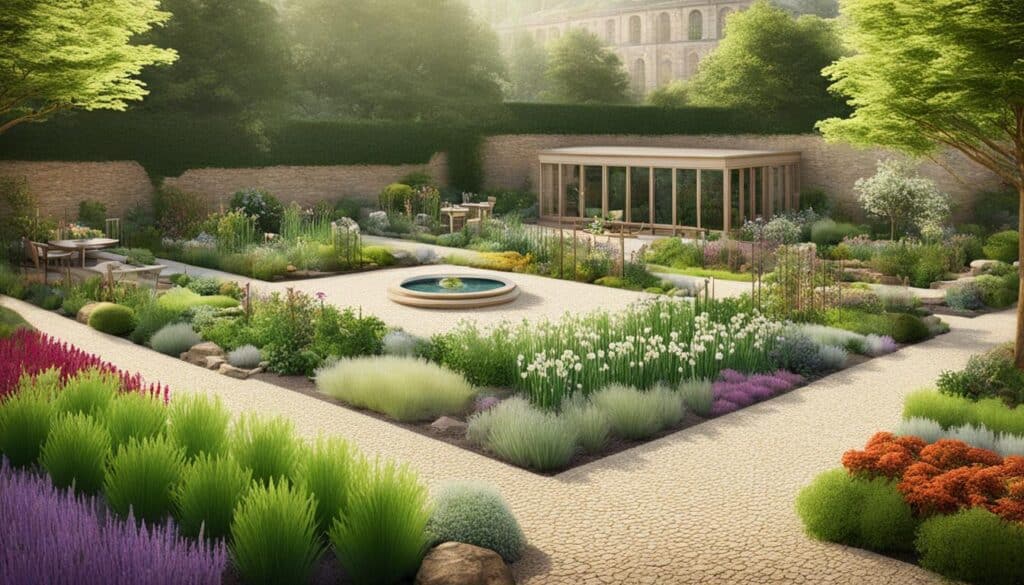
The intertwining of nature with human health is not a recent concept. The history of healing gardens and their therapeutic uses can be traced back to ancient civilizations where gardens were seen as sanctuaries for healing the body and the mind. As we delve into the roots of horticulture wellness benefits, we uncover a rich tapestry of practices that fostered the evolution of today’s therapeutic landscape.
Ancient Practices to Modern Developments
From the hanging gardens of Babylon to the monastic herb gardens of the Middle Ages, green spaces have been historically revered for their medicinal and restorative qualities. It was common in ancient Egypt, Greece, and Rome to incorporate plant elements into the healing process, recognizing the innate connection between horticulture and health. Fast forward to the contemporary era, the concept has been refined and integrated into modern healthcare practices, with gardens being designed specifically to aid recovery, reduce stress, and improve overall well-being.
Pioneers in Horticulture Therapy
Recognition of horticulture therapy as a formalized practice chiefly rooted in the efforts of American horticulturalists and healthcare professionals who advocated for the therapeutic potential of gardening activities. The establishment of educational programs, such as the Certificate in Horticultural Therapy at the University of Florida, paved the way for the operational framework within which garden therapy would flourish, nurturing a discipline that marries botany with the caring aspects of healthcare.
Today’s therapeutic gardens, shaped by evidence-based research and the legacies of leaders in the domain, stand as testaments to the enduring relationship between humans and plants—a relationship where nurture begets wellness, and where cultivation goes hand in hand with recuperation.
Characteristics of Therapeutic Garden Design
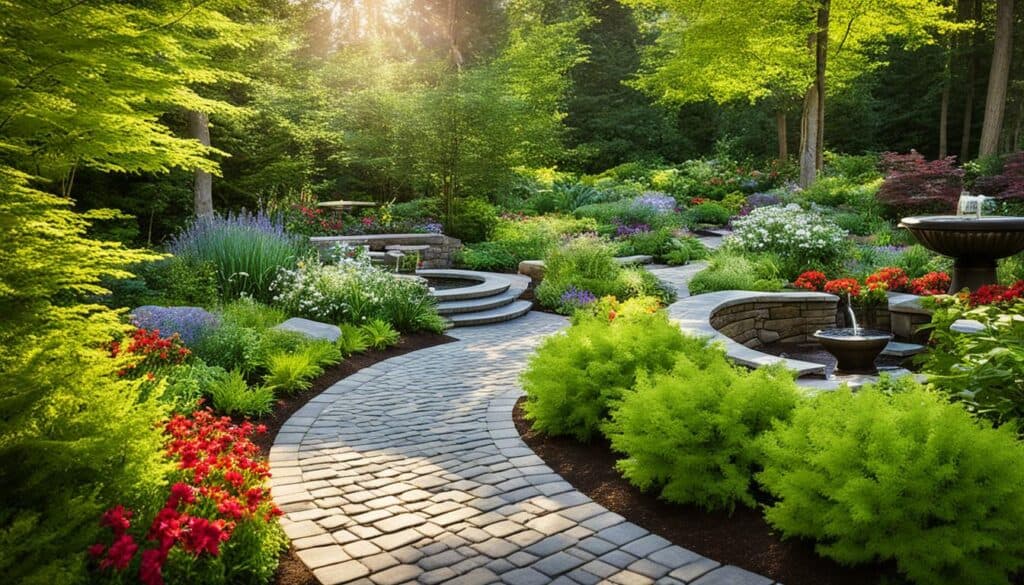
In the arena of creating therapeutic outdoor spaces, design elements are not only chosen for their aesthetic value but also for their capacity to promote healing and well-being. A successful therapeutic landscape is an interplay of art and science, incorporating accessibility and sensory-rich experiences that cater to a wide spectrum of users. As we delve into this niche of landscape architecture, we acknowledge the critical features that underpin these restorative environments.
- Accessibility: Ensuring that garden pathways are wide and gently sloped, allowing easy access for wheelchairs, walkers, and those with physical limitations.
- Ergonomics: Including planters and garden beds at various heights to make gardening activities comfortable for individuals of all abilities.
- Sensory Engagement: Integrating a diverse collection of plants that appeal to the senses – visually through color and texture, aromatically with fragrances, aurally with the rustling of leaves or flowing water, and tactilely with varied foliage.
- Collaborative Design: Working in conjunction with skilled horticultural therapists, landscape designers craft spaces that not only fulfill aesthetic goals but also address the specific therapeutic needs of users.
The incorporation of these features is paramount in fostering spaces that do not merely exist as gardens, but thrive as hubs of wellness, comfort, and restoration. Designers and therapists strive to create settings that invite interaction and awaken the senses, offering a refuge that supports physical and mental health. The collaboration between design and therapy is a testament to the profound understanding that the environment holds therapeutic potential – making each garden a catalyst for restoration and serenity.
Embracing Horticulture Wellness Benefits Across Ages

The intergenerational appeal of healing gardens is becoming increasingly apparent, with the myriad benefits of horticulture wellness permeating through various stages of life. From the vitality of youth to the tranquility of older age, the therapeutic landscapes of garden therapy offer a universal respite and a nurturing touch for both mental health and physical vigor.
Impact on the Elderly and Those with Cognitive Disabilities
For the elderly and individuals with cognitive disabilities, the serene ambiance of healing gardens has provided a noticeable uplift in mood and mental acuity. The gentle, yet engaging nature of these spaces can lead to significant improvements in well-being:
- Reduction in stress levels and anxiety
- Enhancement in overall mood and emotional state
- Increase in social interaction and community engagement
- Stimulation of cognitive functions through sensory garden elements
Gardening Interventions for the Younger Population
Younger demographics are not left behind when it comes to experiencing the horticulture for health phenomenon. Garden therapy enables vital educational experiences and a stronger connection with nature through innovative programs:
- Mobile food trucks that teach about fresh, locally grown produce
- Farm to school networks that foster a farm-to-table understanding
- Community gardens that promote hands-on learning and nutritional awareness
Garden therapy thus presents a versatile and beneficial approach for enhancing mental health and fostering an appreciation for sustainable living among the younger population.
How to Create a Healing Garden: Design Principles and Considerations
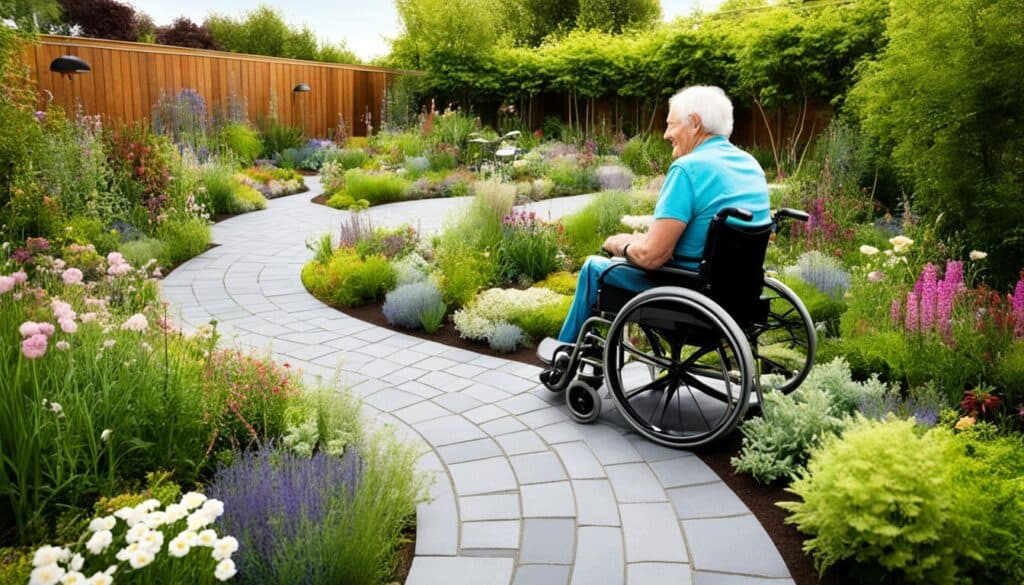
Creating therapeutic outdoor spaces goes beyond aesthetics and into the realm of well-being, where design meets the nuanced needs of its users. The careful integration of therapeutic garden design principles can yield spaces that not only comfort and heal but also engage and empower. A two-fold approach, focusing on sensory engagement and inclusivity, forms the crux of crafting these serene, responsive environments.
Layering for Sensory Engagement
The first principle in designing a healing garden is layering various elements to stimulate the senses. Strategic use of plant textures, vivid colors, and alluring fragrances are pivotal in creating a therapeutic landscape that encourages interaction and elicits a positive emotional response. Consider including:
- Flowering plants and shrubs for visual and olfactory stimulation
- Textured pathways that produce calming sounds underfoot
- Edible herbs and vegetables for taste-based experiences
- Wind chimes or water features to create ambient sounds
This rich, sensory tapestry supports the objectives of many horticultural therapy programs, aiding in cognitive, physical, and emotional rehabilitation.
Accessibility and Inclusiveness in Healing Garden Design
Accessibility is at the heart of inclusive garden design, ensuring that everyone can benefit from the therapeutic qualities of nature. Key considerations should include:
- Wide and gently graded pathways to accommodate wheelchairs and walkers
- Varied seating options for resting and enjoying the garden
- Labels in Braille and other languages for diverse visitor engagement
- Adaptive gardening tools and elevated planters for those with limited mobility
Effectively implemented, these design choices promote equity in healing garden access, inviting a broad spectrum of visitors to engage in the nurturing presence of nature.
Together, these strategic approaches underscore the holistic mission of therapeutic garden design, where every thoughtful addition contributes to a restorative and inclusive experience for all. By emphasizing both sensory-rich features and universal accessibility, these outdoor spaces become sanctuaries of health, healing, and harmony.
The Role of Water Features in Healing Gardens
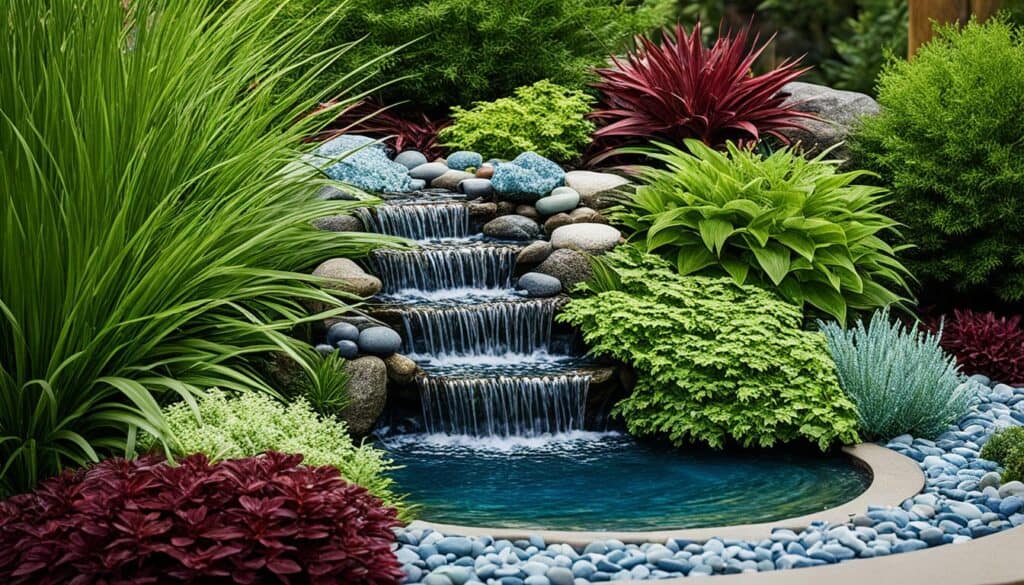
Integrating water features into healing gardens plays a pivotal role in enhancing the therapeutic quality of these serene landscapes. With their inherent ability to promote tranquility and mindfulness, water features contribute significantly to the sensory experience and to the healing efficacy of garden environments.
Water elements serve multiple functions within the healing garden, from aesthetic enhancement to the therapeutic influence they exert on individuals. The soothing sound of flowing water captivates the auditory senses, eliciting a calming effect that can decrease stress levels and bolster mental well-being.
- Visual Appeal: The glistening surface of the water reflects the sky and surrounding greenery, creating a dynamic interplay of color, light, and movement that captivates the eye and soothes the mind.
- Auditory Stimulation: Gently cascading waterfalls or burbling streams introduce a calming soundtrack to the garden, harnessing the therapeutic power of sound to enhance the restorative experience.
- Physical Interaction: The opportunity to physically engage with water through features such as rills or touch pools can provide tactile therapy and encourage mindful interaction with the environment.
- Wildlife Attraction: Water features attract a variety of wildlife, such as birds and butterflies, which contribute to the garden’s biodiversity and offer visitors another layer of connection to nature.
Water features are not only aesthetically pleasing but are also an integral component of therapeutic landscapes, fostering a deeper sense of peace and promoting the restorative atmosphere vital to healing gardens.
Plant Selection for Therapeutic Outcomes
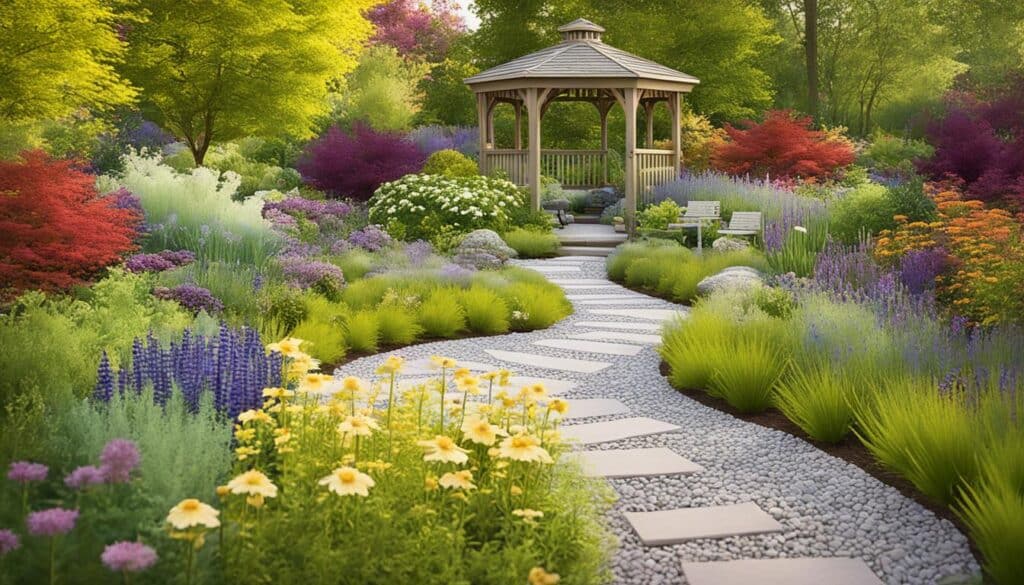
Integrating healing garden plants within a landscape not only enhances its beauty but also contributes significantly to health and well-being. A healing garden’s design is thoughtfully outlined to incorporate therapeutic garden design principles, ensuring every plant serves a purpose. Whether aiming to reduce stress, stimulate the senses, or support specific healthcare outcomes, the plant selection process is a foundational aspect of creating a therapeutic environment.
Choosing Plants with Purpose
Each plant chosen for inclusion in a healing garden supports the overall therapeutic intent of the space. Aromatic herbs may be selected for their calming scents, while sturdy shrubs and tactile grasses can withstand touch and interaction. Here are some key considerations when selecting plants:
- Investigate the sensory benefits of each plant, including texture, color, fragrance, and sound.
- Consider the therapeutic properties, such as relaxing or invigorating effects.
- Choose plants that can thrive in the local climate and serve the desired therapeutic functions.
- Ensure a variety of plants that can cater to a wide range of physical and emotional needs.
The Significance of Seasonal Variation
Embracing seasonal variation in healing gardens is another cornerstone principle that contributes to the lasting impact of the space. Seasonally varied planting ensures the garden remains engaging and beneficial year-round, adapting to the changes in climate and the evolving needs of its users. This dynamic aspect of garden design taps into the profound benefits of healing gardens, offering a visually stimulating and therapeutic experience no matter the season.
- Spring: Incorporate early bloomers that signal the renewal of life.
- Summer: Choose a mix of vibrant flowers and lush greenery to enhance vitality.
- Fall: Select plants with striking autumnal hues and textures to reflect the changing season.
- Winter: Utilize evergreens and winter-blooming plants to maintain the garden’s appeal.
By thoughtfully selecting plants that honor these principles, healing gardens serve as powerful repositories for both physical healing and mental restoration, cultivating a harmonious sanctuary that resonates with nature’s intrinsic rhythms and the human spirit.
Mental Health and Emotional Recovery Through Garden Therapy
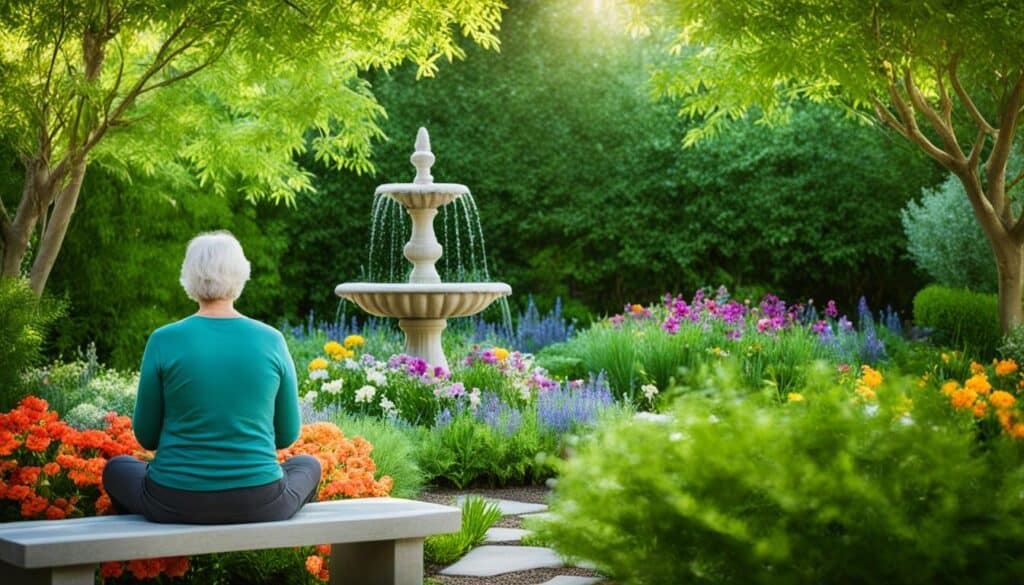
Garden therapy for mental health presents itself as a cornerstone in the promotion of emotional well-being. Through the tactile and sensory experiences provided by horticulture, individuals find themselves immersed in an environment tailored for tranquility and introspection. The structured yet organic nature of this approach is why horticulture wellness benefits are being increasingly recognized by mental health professionals.
The therapeutic value of gardens extends beyond their aesthetics, as they serve as nurturing sanctuaries where individuals can engage in self-reflection and decompression. A multitude of benefits stem from this alignment with nature, including substantial stress alleviation and fostering a unique connection with the natural world.
- Reduction of anxiety and depression symptoms through consistent interaction with the living environment.
- Enhancement of mood and promotion of relaxation via engagement with plant cultivation and care.
- Opportunities to experience mindfulness and present-moment awareness amid the greenery.
With facilities around the country integrating therapeutic landscapes into their architecture, the impact of garden therapy upon mental wellness is gaining visibility. These spaces are meticulously designed to promote psychological restoration and are integral elements in recovery programs for various mental health challenges.
Benefits of Healing Gardens in Reducing Stress and Anxiety
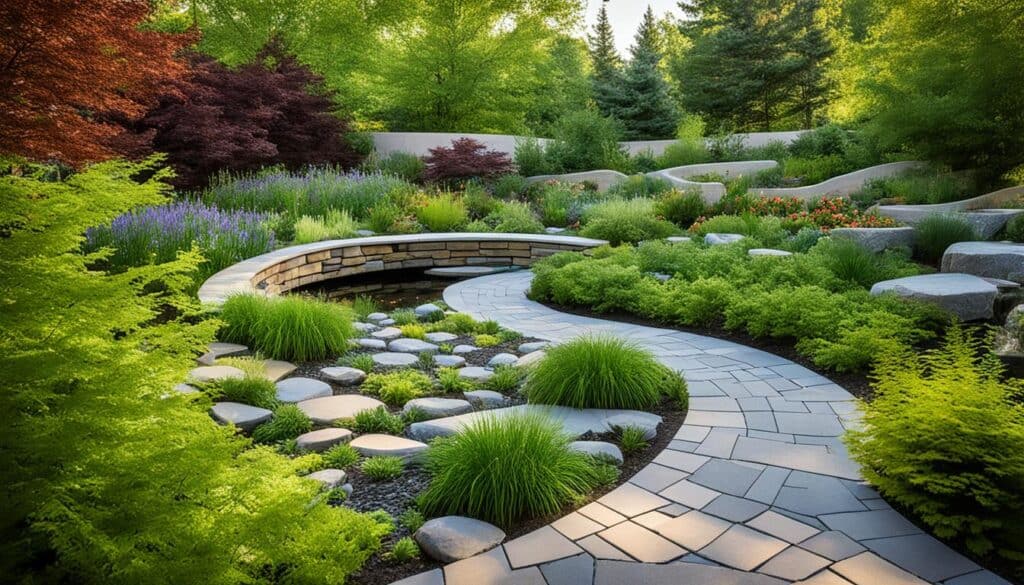
Gardening is not just a pleasurable pastime; it’s a potent therapeutic tool that intersects with health to enrich our lives. Beyond the visual allure and aesthetic appeal, therapeutic landscapes serve as sanctuaries of solace and stress reduction. This section delves into the impact of garden therapy on stress reduction, underscoring findings from scientific studies and presenting real-world case studies that exemplify the profound benefits of healing gardens.
Scientific Studies on Stress Reduction
Research has shed light on the intersection between nature and neuroscience, revealing the impact of garden therapy on neuroendocrine functions. Numerous studies have observed a notable decrease in cortisol levels, the stress hormone, following periods spent in garden settings. This biochemical evidence is complemented by self-reported feelings of tranquility and lower levels of anxiety by participants. As such, the clinical incorporation of therapeutic landscapes has gained traction as a complementary approach to conventional stress-reduction modalities.
Case Studies: Real-World Applications and Outcomes
Case studies provide a concrete lens through which we can assess the effectiveness of healing gardens. Documented instances at healthcare facilities highlight how patients engaging in garden therapy exhibit accelerated recuperation rates and reduced reliance on medication. In rehabilitation centers, custom-designed gardens cater to patients’ specific therapeutic needs, encouraging physical activity and fostering a profound sense of well-being. Such practical applications stand as testament to the versatility and tangible benefits of horticultural therapy in stress management and emotional recovery.
- Hospitals incorporating roof-top gardens to promote patient and staff well-being
- Rehabilitation centers utilizing sensory gardens to aid in recovery
- Community gardens acting as preventative stress-reduction environments
Healing Gardens as Community and Social Spaces

Within the green tapestry of urban landscapes, healing gardens emerge as transformative spaces where communities coalesce, forging connections with nature and each other. Offering more than a lush respite from concrete environs, these gardens encapsulate the essence of therapeutic leisure and socialization, laying down roots for societal enrichment and kinship.
Building Social Ties Through Gardening Activities
Healing gardens foster an environment ripe for social interaction, blossoming into social spaces where garden therapy for mental health becomes an interactive pursuit. Through joint efforts in sowing, tending, and harvesting, individuals cultivate more than plants—they nurture lasting relationships built on shared experiences and a mutual appreciation for the restorative qualities of horticulture. These activities are not only a catalyst for community engagement but also a means to empower individuals with a sense of accomplishment and belonging.
Nurturing Community Well-being
Extending beyond the individual, healing gardens sow the seeds for community well-being through horticulture, becoming vital components in the fabric of social welfare. Through programs that target food deserts and educational projects within schools, gardens become the center of gravity for initiatives designed to bolster nutritional knowledge and ensure that community vitality flourishes alongside verdant plots of communal land.
- Community gardens as a natural haven for fostering friendships and support networks
- School gardens promoting inclusivity and hands-on learning for the next generation
- Horticultural activities as therapeutic tools to improve mental and societal health
Horticulture Therapy Programs and Their Implementation
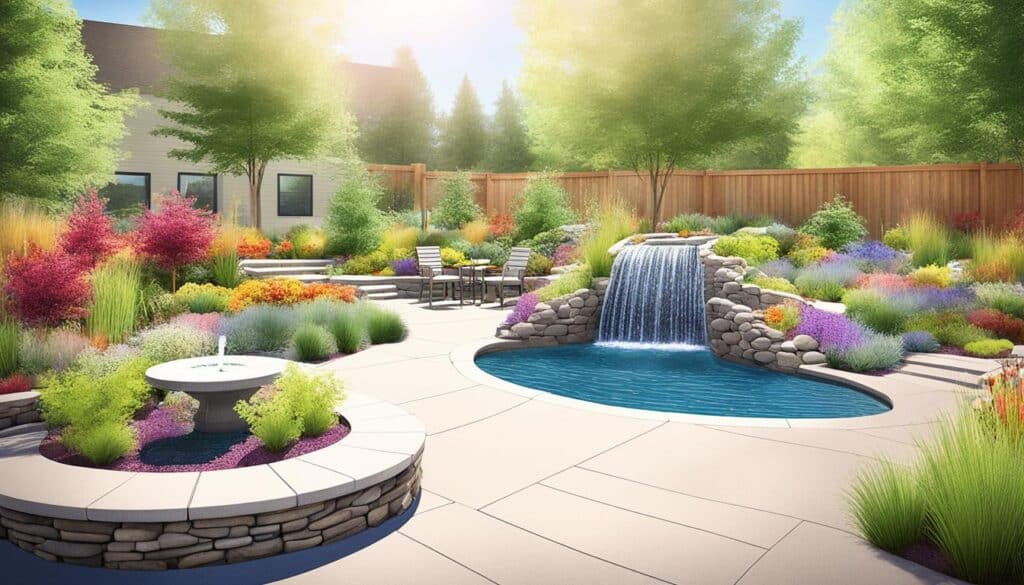
As society embraces the burgeoning field of horticulture therapy, the significance of a solid educational framework for horticulture therapy becomes increasingly apparent. This has led to an emerging generation of professionally certified horticultural therapists dedicated to integrating garden therapy for mental health within various community landscapes. Such advancements are paramount to standardizing the practice and ensuring its effective application in therapeutic settings.
Educational Framework and Certification
The establishment of a comprehensive educational framework paves the way for aspiring horticultural therapists to acquire the knowledge and skills necessary for the profession. Institutions have developed certifications that endorse the high standards and competencies required in this field, thereby fortifying the credibility of horticulture therapy as a vital component of integrative health care.
Activating Spaces: Horticulture Projects in Different Settings
Across the United States, the activation of therapeutic outdoor spaces within diverse environments, from hospitals to community gardens, is demonstrative of the adaptability and versatility of horticultural therapy programs. These purpose-driven endeavors involve participants actively engaging with nature, providing therapeutic benefits through tailored plant-centric activities.
Utilizing Green Spaces for Education and Nutritional Awareness

The integration of education through horticulture and nutritional awareness in garden therapy is transforming green spaces into multifaceted learning environments. These natural classrooms offer unique experiences where individuals can gain a comprehensive understanding of how sustainable food systems are linked to our health and the environment. Nutrition education within these verdant learning hubs plays a crucial role in addressing community health disparities by providing hands-on experiences that encourage healthier eating habits and food choices.
At the heart of garden therapy, programs aimed at bridging the gap between knowledge and practice are empowering communities with the skills needed to foster long-term health benefits. Below is a look at various initiatives that embody the holistic philosophy of garden therapy:
- Nutrition education workshops that give practical tips on incorporating home-grown produce into a balanced diet.
- Training sessions on sustainable agricultural practices that emphasize the importance of biodiversity and soil health for plant-based nutrition.
- Community outreach programs that engage people of all ages in the joy of growing and preparing their own meals.
- Food literacy nonprofits that focus on equipping underserved communities with the knowledge necessary to navigate food systems.
- Green exercise activities, such as guided garden walks and yoga sessions, that link physical activity with the calming effects of nature.
These concerted efforts in green spaces not only enhance the educational landscape but also forge a deeper connection between individuals and the food they consume. In this way, education through horticulture and nutritional awareness is not just a cornerstone of garden therapy but also a vital component of community wellness strategies.
Gardening as a Tool for Physical Rehabilitation and Recovery
The practice of gardening for physical rehabilitation is more than just a hobby; it’s a catalyst for recuperation and resilience. Those who are recovering from physical ailments often need therapies that extend beyond traditional clinical settings. Gardens, as therapeutic landscapes, provide a rich, calming environment where the process of working with soil and plants aids in the physical rehabilitation of patients. The act of gardening involves a range of motions that can help improve motor skills, enhance flexibility, and build physical strength, thus wielding the soil and seeds directly supports restoring the body’s capabilities.
Therapeutic landscapes are exquisitely designed with accessibility and the physical needs of individuals in mind. Gardens tailored for rehabilitation are equipped with features that accommodate patients navigating through recovery. For example, raised beds and ergonomic tools are considered essential in gardening paradigms that aim to support individuals with mobility challenges. Within these healing spaces, patients engage in garden therapy that not only nurtures plants but also fortifies their own physical and emotional wellness through a harmonious blend of nature and nurturing.
Successfully integrating garden therapy into a rehabilitation program requires an understanding of each patient’s unique situation and tailoring the therapeutic activities to fit their specific recovery path. Through repetitive and purpose-driven gardening tasks, patients can improve their endurance and muscle strength, often resulting in an accelerated path to recovery. It’s through the cultivation of life in gardens that many patients find a renewed strength and a tranquil reprieve, bolstering both their body and spirit.
 Fullersears
Fullersears





